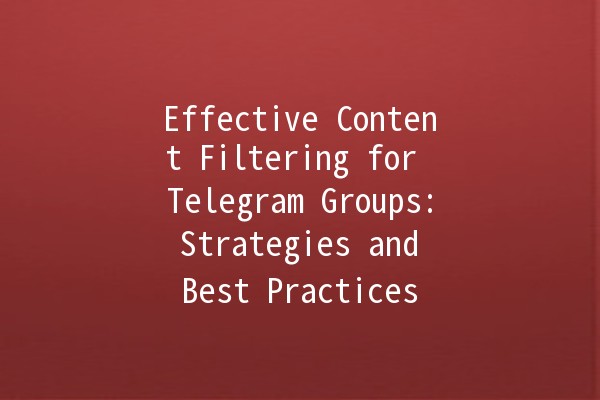Effective Content Filtering for Telegram Groups: Strategies and Best Practices

Telegram has become one of the most popular messaging platforms in the digital age, fostering communities around shared interests, hobbies, and professional goals. With over 500 million active users, the platform offers an ideal environment for interaction through groups. However, managing content in these groups can be an overwhelming task, especially when dealing with a plethora of messages that can clutter the conversation and detract from its quality.
This article will explore various strategies for effectively filtering content in Telegram groups, maximizing engagement, and ensuring that discussions remain relevant and constructive. We will cover essential techniques, tools, and best practices that can help group administrators maintain a healthy digital environment.
Understanding the Importance of Content Filtering
Before diving into strategies, it is critical to understand why content filtering is vital in Telegram groups. Here are several reasons:
Establishing Clear Group Guidelines

The foundation of effective content filtering begins with welldefined guidelines. Here are steps to establish these guidelines:
Clearly outline the group’s purpose. Whether it's for sharing tips, hosting discussions, or networking, a defined focus helps members understand the type of content that is appropriate.
Outline what constitutes acceptable and unacceptable content. This can cover areas like:
Prohibited behavior: Hate speech, bullying, and spam.
Relevant topics: Specify which topics should be discussed and which are offlimits.
Media sharing: Set rules on sharing images, videos, and links.
Make sure all members are aware of the guidelines. Pin a message in the group or create a dedicated section for rules. Regular reminders can also help reinforce these standards.
Implementing Administrative Tools
Using Telegram's various tools can significantly improve content filtering. Here are some of the effective options available:
Bots can be incredibly useful for automating tasks related to content filtering. Here are a few functions they can assist with:
Keyword Filtering: Bots can be programmed to filter out specific keywords, phrases, or links that violate group guidelines.
Spam Detection: Bots can recognize repeated messages or links and automatically delete them to keep the chat clean and organized.
User Management: Administrators can set bots to automatically mute, kick, or ban users who violate group rules, streamlining the moderation process.
By assigning specific roles to group members, administrators can manage content more effectively:
Moderators: Designate trusted members as moderators to help enforce rules and keep conversations on track.
Restricting Permissions: Limit new members' abilities to post until they have shown they understand the group guidelines.
Regularly auditing content can help catch any ongoing issues that may not have been addressed. Administrators should establish a routine for reviewing conversations and identifying any problematic patterns.
Encouraging Member Participation and Responsibility
While administrators play a significant role in content filtering, encouraging members to actively participate in maintaining group standards is also crucial:
Encourage members to treat one another with respect and to selfmoderate where possible. Having a supportive community will likely lead to adherence to the established guidelines.
Create an open channel for member feedback regarding group content. This can help identify areas needing improvement and can foster a sense of ownership among the members.
Recognizing and rewarding members who significantly contribute positively to the group can motivate others to follow suit and create quality discussions.
Leverage Feedback Mechanisms
Involving members in the content management process can further help in maintaining a healthy group environment:
Conduct regular polls or surveys to gauge members' opinions on the group's direction and discuss what kind of content they prefer.
Create a dedicated channel or message thread for members to submit content ideas or improvements to group policies.
Monitoring Trends and Adapting
To maintain effective content filtering, group administrators must stay updated on the evolving nature of online communication. Here are tips to remain relevant:
Monitor current digital trends and memes, as these can influence group conversations. Understanding popular discourse will help in moderating discussions effectively.
As the community evolves, revisit and revise guidelines at regular intervals. Ensure they remain relevant to the changing interests of group members.
Handling Difficult Situations
Despite the best laid plans, conflicts may arise. Here are the best practices for managing difficult situations:
Don’t let conflicts fester. Address problematic content or behavior quickly to maintain trust and respect within the group.
When dealing with conflicts involving specific users, it's often best to address issues in private messages to prevent escalation in the public chat.
As an administrator, always aim to approach conflicts neutrally. Avoid personal bias while maintaining objectivity to reassure members of a fair moderation process.
Effective content filtering in Telegram groups involves a combination of clearly defined guidelines, the right tools, member participation, and adaptive strategies. By fostering a respectful community and prioritizing safe, constructive communication, group administrators can create a welcoming environment that encourages meaningful interactions.
Ultimately, the goal of any Telegram group is to connect people around shared interests. By implementing these strategies, administrators can ensure that discussions remain focused, relevant, and engaging, allowing their communities to thrive in an increasingly digital world.
In summary, successful content filtering is not just about restricting what is said; it's about creating the right context for valuable conversations to take place. As Telegram continues to evolve, so too should our approaches to managing the communities that choose to call it home.
Other News

如何在TelegramX中进行群组投票 🤖📊

Telegram安装时间优化 🚀📱

Telegram Mac版下載地址及其特色功能探索!
